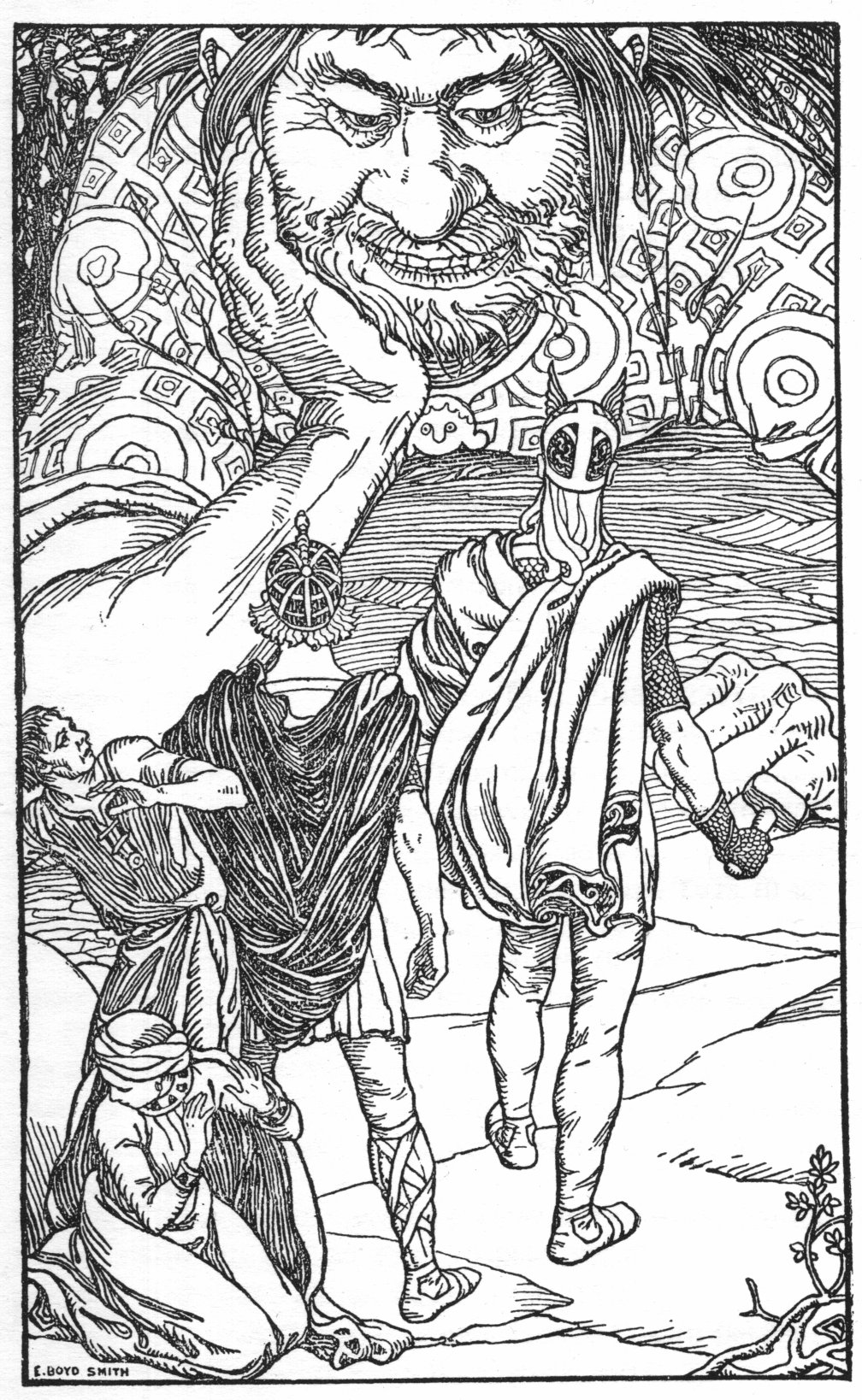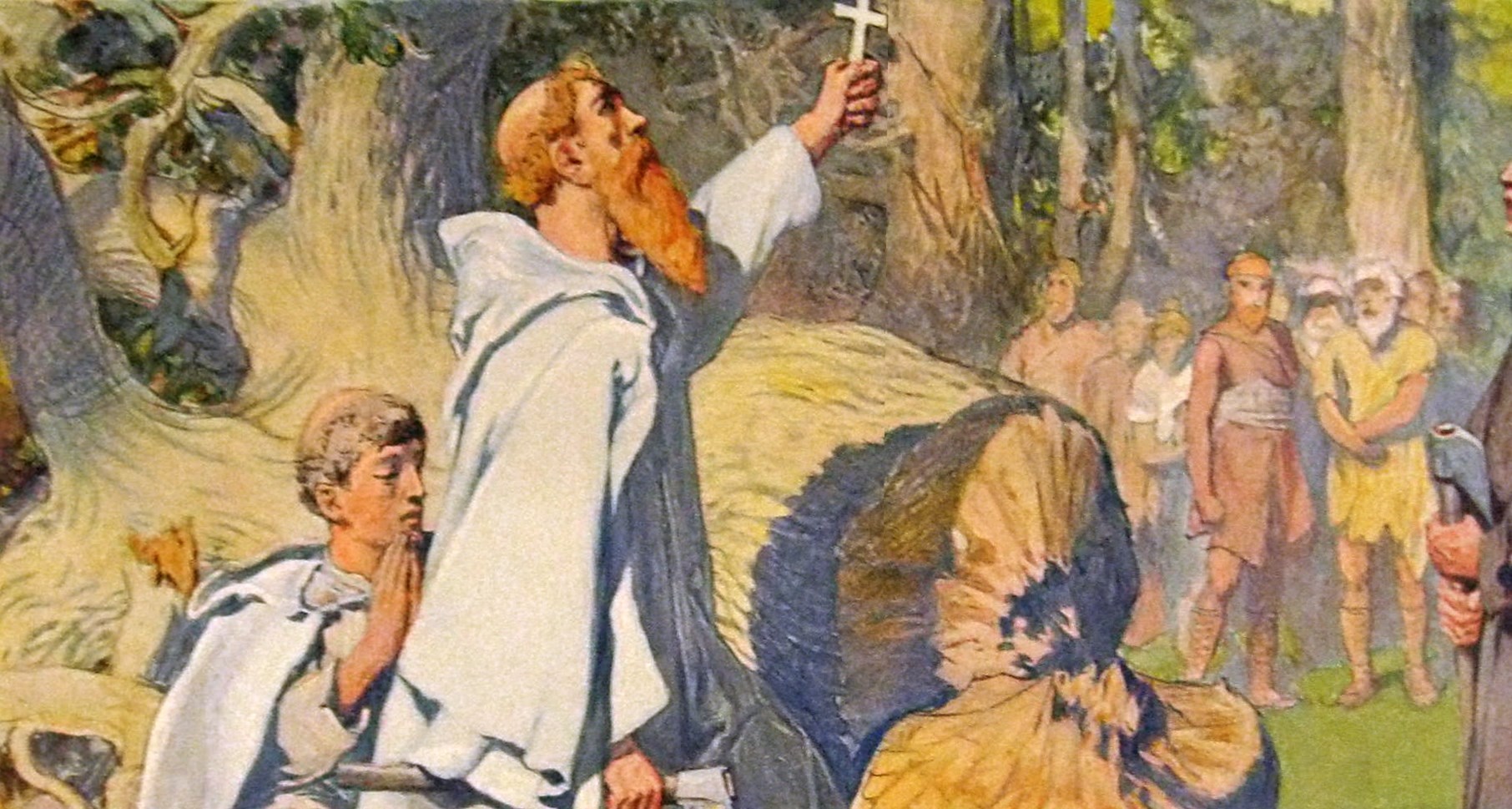|
ΟötgarΟΑa-Loki
In Norse mythology, ΟötgarΟΑa-Loki (Anglicized as Utgarda-Loki, Utgard-Loki, and Utgardsloki) is the ruler of the castle ΟötgarΟΑr in JΟΕtunheimr. He is one of the jΟΕtnar and his name means literally "Loki of the Outyards" or "Loki of the Outlands", to distinguish him from Loki, the companion of Thor. He was also known as SkrΟΫmir or Skrymir. ''Prose Edda'' In the ''Prose Edda'' book ''Gylfaginning'' (chapter 44), the enthroned figure of High, Just-As-High, and Third, Third reluctantly relates a tale in which Thor, Loki and Thor's servants, ΟûjΟΓlfi and RΟΕskva are traveling to the east. They arrive at a vast forest in JΟΕtunheimr, and they continue through the woods until dark. The four seek shelter for the night and discover an immense building. Finding shelter in a side room, they experience earthquakes through the night. The earthquakes cause all four to be fearful, except Thor, who grips MjΟΕlnir, his hammer in defense. The building turns out to be the huge glove of SkrΟΫmi ... [...More Info...] [...Related Items...] OR: [Wikipedia] [Google] [Baidu] |
ΟûjΟΓlfi And RΟΕskva
In Norse mythology, ΟûjΟΓlfi (Old Norse: ) and RΟΕskva (O.N.: ), also known as Thjalfi and Roskva, are two siblings, a boy and a girl, respectively, who are servants of the god Thor. ΟûjΟΓlfi receives a single mention in the ''Poetic Edda'', compiled in the 13th century from earlier traditional material, while both ΟûjΟΓlfi and RΟΕskva are attested in the ''Prose Edda'', written in the 13th century by Snorri Sturluson and in poetry of skalds. In the ''Poetic Edda'', Thor recounts an incident where ΟûjΟΓlfi is chased away by she-wolves but gives no additional information about him. In the ''Prose Edda'', ΟûjΟΓlfi and RΟΕskva are the children of peasant farmers. Thor and Loki stay a night at their farmstead and there Thor shares with the family the meat of his goats, Tanngrisnir and TanngnjΟ≥str, which he can resurrect provided that their bones are intact. ΟûjΟΓlfi sucks the bone marrow, marrow from a leg bone from one of the goats. When Thor resurrects the goats the next morning, ... [...More Info...] [...Related Items...] OR: [Wikipedia] [Google] [Baidu] |
Loki
Loki is a ΟÜsir, god in Norse mythology. He is the son of FΟΓrbauti (a jΟΕtunn) and Laufey (mythology), Laufey (a goddess), and the brother of Helblindi and BΟΫleistr. Loki is married to the goddess Sigyn and they have two sons, Narfi (son of Loki), Narfi or Nari and VΟΓli (son of Loki), VΟΓli. By the jΟΕtunn AngrboΟΑa, Loki is the father of Hel (being), Hel, the wolf Fenrir and the world serpent JΟΕrmungandr. In the form of a mare, Loki was impregnated by the stallion SvaΟΑilfari and gave birth to the eight-legged horse Sleipnir. Like other gods, Loki is a Shapeshifting, shape shifter and in separate sources appears in the form of a salmon, a mare, a Fly (animal), fly, and possibly an elderly woman named ΟûΟΕkk (Old Norse 'thanks'). While sometimes friendly with the gods, Loki engineers the death of the beloved god Baldr. For this, Odin's specially engendered son VΟΓli binds Loki with the entrails of one of his sons, where he writhes in pain. In the ''Prose Edda'', this son, Nar ... [...More Info...] [...Related Items...] OR: [Wikipedia] [Google] [Baidu] |
JΟΕrmungandr
In Norse mythology, JΟΕrmungandr (, see Etymology), also known as the Midgard Serpent or World Serpent (, "worm of Midgard"), is an unfathomably large and monstrous sea serpent or worm who dwells in the world sea, encircling the Earth ( Midgard) and biting its own tail, an example of an ouroboros. As a result of him surrounding Midgard, the beast is referred to as the World Serpent. JΟΕrmungandr releasing his tail is one of the signs of the beginning of RagnarΟΕk. JΟΕrmungandr is said to be the middle child of the god Loki and the jΟΕtunn AngrboΟΑa. According to the ''Prose Edda'', Odin took Loki's three children by AngrboΟΑa βÄ™ the wolf Fenrir, underworld ruler Hel, and the serpent JΟΕrmungandr βÄ™ and removed them from Asgard (the world of the ΟÜsir). The serpent JΟΕrmungandr was tossed into the great ocean that encircles Midgard.Snorri Sturluson; Brodeur, Arthur Gilchrist (trans.) (1916). '' The Prose Edda''. New York: The American-Scandinavian Foundation. '' Gyl ... [...More Info...] [...Related Items...] OR: [Wikipedia] [Google] [Baidu] |
Elli
In Norse mythology (a subset of Germanic mythology), Elli (Old Norse: , "old age"Orchard (1997:38).) is a personification of old age who, in the ''Prose Edda'' book ''Gylfaginning'', defeats Thor in a wrestling match.Graeme Davis (2013). ''Thor: Viking God of Thunder''. Bloomsbury Publishing. ''Gylfaginning'' In ''Gylfaginning'', Thor and his companions Loki and ΟûjΟΓlfi are in the hall of the jΟΕtunn ΟötgarΟΑa-Loki where they meet difficult challenges testing their strength and skill. Thor has just been humiliated in a drinking challenge and wants to get even. Then said Thor: 'Little as ye call me, let any one come up now and wrestle with me; now I am angry.' Then Οötgarda-Loki answered, looking about him on the benches, and spake: 'I see no such man here within, who would not hold it a disgrace to wrestle with thee;' and yet he said: 'Let us see first; let the old woman my nurse be called hither, Elli, and let Thor wrestle with her if he will. She has thrown such men as have ... [...More Info...] [...Related Items...] OR: [Wikipedia] [Google] [Baidu] |
Thor
Thor (from ) is a prominent list of thunder gods, god in Germanic paganism. In Norse mythology, he is a hammer-wielding ΟΠsir, god associated with lightning, thunder, storms, sacred trees and groves in Germanic paganism and mythology, sacred groves and trees, Physical strength, strength, the protection of humankind, hallowing, and fertility. Besides Old Norse , the deity occurs in Old English as , in Old Frisian as ', in Old Saxon as ', and in Old High German as , all ultimately stemming from the Proto-Germanic theonym , meaning 'Thunder'. Thor is a prominently mentioned god throughout the recorded history of the Germanic peoples, from the Roman Empire, Roman occupation of regions of , to the Germanic expansions of the Migration Period, to his high popularity during the Viking Age, when, in the face of the process of the Christianization of Scandinavia, emblems of his hammer, , were worn and Norse paganism, Norse pagan personal names containing the name of the god bear witness ... [...More Info...] [...Related Items...] OR: [Wikipedia] [Google] [Baidu] |
Logi (mythology)
Logi (Old Norse: , 'fire, flame') or HΟΓlogi (, 'High Flame') is a jΟΕtunn and the personification of fire in Norse mythology. He is a son of the jΟΕtunn FornjΟ≥tr and the brother of ΟÜgir or HlΟ©r ('sea') and KΟΓri ('wind'). Logi married fire giantess GlΟΕΟΑ and she gave birth to their two beautiful daughtersβÄîEisa and Eimyrja. Name The Old Norse name ''Logi'' is generally translated as 'fire', 'flame', or blaze'. It was also used in poetry as a synonym of 'sword, blade'. Since Logi is pitted against the god Loki in a story in the ''Gylfaginning'' section of the ''Prose Edda'', it has been suggested that Loki was also associated with fire, but it is more likely to be wordplay. Loki has no provable connection to the German word ''Lohe'' ('blaze'), despite Richard Wagner's use of the name ''Loge'' for the demigod in his '' Ring des Nibelungen''. Attestations ''Gylfaginning'' In ''Gylfaginning'' ('The Beguiling of Gylfi'), Logi appears in the tale of Thor and Loki's jour ... [...More Info...] [...Related Items...] OR: [Wikipedia] [Google] [Baidu] |
ΟötgarΟΑar
In Norse mythology, ΟötgarΟΑar (literally: "Outyards", the plural of ΟötgarΟΑr; the word can, according to Old Norse orthography, be anglicized as Utgard, Utgardar and in other ways) surrounded a stronghold of the jΟΕtnar. They are associated with ΟötgarΟΑa-Loki, a great and devious jotunn featured in one of the myths concerning Thor and the other Loki who competed in rigged competitions held in the Outyards. These outdoor arenas contrasted with the putrid, indoor cave where ΟötgarΟΑa-Loki is said to have dwelt, when chained, in the 12th-century ''Gesta Danorum''. In another version of Norse mythology, Utgard is thought to be the last of the three worlds connected to Yggdrasil, being the home of the external cosmic forces. Utgard needs to be compared with the Midgard, the world of human affairs, and Asgard, variously attested at the crux of the matter, the centre of the world, as identified with Troy by Snorri Sturluson Snorri Sturluson ( ; ; 1179 βÄ™ 22 September 1241) ... [...More Info...] [...Related Items...] OR: [Wikipedia] [Google] [Baidu] |
Valhalla (1986 Film)
''Valhalla'' is a Danish animated feature film released in 1986 by Metronome, based on volumes one, four and five of the comics series of the same name, in its turn based on the Scandinavian tales of the Norse mythology, as they are told in Snorri Sturlusons so-called Younger Edda (c. 1230), and in the Poetic Edda. It was directed by Disney animator Jeffrey J. Varab and cartoonist Peter Madsen, the latter of which is one of the writers and the main artist on the ''Valhalla'' comics. The movie takes plot elements told from the three comic albums "Cry Wolf", "The Story of Quark" and "The Journey to Utgard-Loki". The film was the most expensive Danish film of 1986 and proved popular with audiences with over half a million sold tickets, matching a tenth of Denmark's population at the time. However the enormous cost of the film prevented the producers from regaining the cost of production and, as a result, the film became a financial flop at the box office. Plot Thor and Loki h ... [...More Info...] [...Related Items...] OR: [Wikipedia] [Google] [Baidu] |
MjΟΕlnir
MjΟΕlnir ( , ; from Old Norse ''Mj«Ϊllnir'' ) is the hammer of the thunder god Thor in Norse mythology, used both as a devastating weapon and as a divine instrument to provide blessings. The hammer is attested in numerous sources, including the 11th century runic Kvinneby amulet, the ''Poetic Edda'', a collection of eddic poetry compiled in the 13th century, and the ''Prose Edda'', a collection of prose and poetry compiled in the 13th century. The hammer was commonly worn as a pendant during the Viking Age in the Scandinavian cultural sphere, and Thor and his hammer occur depicted on a variety of objects from the archaeological record. Today the symbol appears in a wide variety of media and is again worn as a pendant by various groups, including adherents of modern Heathenry (new religious movement), Heathenry. Etymology The etymology of the hammer's name, ''Mj«Ϊllnir'', is disputed among historical linguistics, historical linguists. Old Norse ''Mj«Ϊllnir'' developed from Prot ... [...More Info...] [...Related Items...] OR: [Wikipedia] [Google] [Baidu] |
JΟΕtunheimr
The terms JΟΕtunheimr (in Old Norse orthography: J«Ϊtunheimr ; often Old Norse orthography#Anglicized spelling, anglicised as Jotunheim) or JΟΕtunheimar refer to either a land or multiple lands respectively in Nordic mythology inhabited by the jΟΕtnar (relatives of the gods, in English sometimes inaccurately called "giants"). are typically, but not exclusively, presented in Eddic sources as prosperous lands located to the north and are commonly separated from the lands inhabited by gods and humans by barriers that cannot be traversed by usual means. Etymology is a compound word formed from and , meaning a 'home' or 'world'. When attested in Eddic sources, the word is typically found in its plural form, ('-lands'). Attestations Poetic Edda are mentioned in three poems of the Poetic Edda. In the beginning of VΟΕluspΟΓ, the coming of three women out of marks the end of the Golden Age#Germanic, Age of Gold for the gods. Towards the end of the poem, in the section describing ... [...More Info...] [...Related Items...] OR: [Wikipedia] [Google] [Baidu] |
Cornus Mas
''Cornus mas'', commonly known as cornel (also the Cornelian cherry, European cornel or Cornelian cherry dogwood), is a species of shrub or small tree in the dogwood family Cornaceae native to Western Europe, Southern Europe, and Southwestern Asia. Description It is a medium to large deciduous shrub or small tree growing to 5βÄ™12 m tall, with dark brown branches and greenish twigs. The leaves are opposite, 4βÄ™10 cm long and 2βÄ™4 cm broad, with an ovate to oblong shape and an entire margin. The flowers are small (5βÄ™10 mm in diameter), with four yellow petals, produced in clusters of 10βÄ™25 together in the late winter (between February and March in the UK), well before the leaves appear. The fruit is an oblong red drupe 2 cm long and 1.5 cm in diameter, containing a single seed. Name ''Cornus mas'', "male" cornel, was named so to distinguish it from the true dogberry, the "female" cornel, ''Cornus sanguinea'', and so it appears in John Gerard' ... [...More Info...] [...Related Items...] OR: [Wikipedia] [Google] [Baidu] |
Gabriel Turville-Petre
Edward Oswald Gabriel Turville-Petre (25 March 1908 – 17 February 1978) was an English philology, philologist who specialized in Old Norse studies. Born at Bosworth Hall (Husbands Bosworth), Bosworth Hall, Leicestershire to a prominent Roman Catholicism, Roman Catholic family, Turville-Petre was educated in English at the University of Oxford under the tutelage of J. R. R. Tolkien. He eventually became Professor of Ancient Icelandic literature, Icelandic Literature and Antiquities at the University of Oxford and a leading member of the Viking Society for Northern Research. He was the husband of fellow philologist Joan Turville-Petre, who was a scholar of Anglo-Saxon studies, Anglo-Saxon and Old Norse studies at Oxford. Turville-Petre was the author of numerous works on Old Norse literature and Old Norse religion, religion which have remained influential up to the present day. Early life Gabriel Turville-Petre was born at his family's ancestral home of Bosworth Hall (Husb ... [...More Info...] [...Related Items...] OR: [Wikipedia] [Google] [Baidu] |






